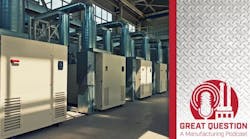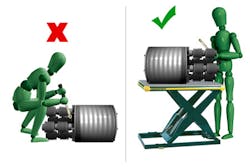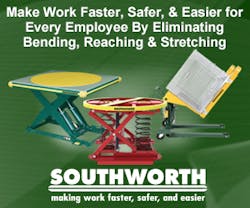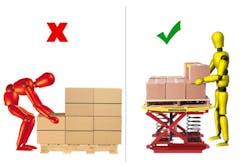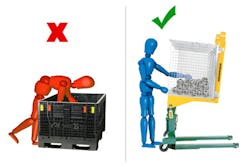Creaking knees, bad backs, and beer bellies aren't the type of attributes most organizations seek in material handling or manufacturing personnel. The reality, though, is that companies may not have many options.
Finding young, healthy workers to perform manual labor is becoming increasingly difficult, says Jim Galante, director of business development at Southworth Products Corp, a maker of ergonomic material handling equipment.
"A young person coming out of a university today is not looking to work in a warehouse," Galante says. "They want to sit behind a computer screen and invent the next big thing."
In fact, older workers—age 55 or older—are projected to make up approximately 26% of the manufacturing labor force by the year 2022, compared with 21% in 2012 and 14% in 2002, according to a report by the Society of Human Resource Management.
While some manufacturers may consider outsourcing or hiring temporary help to fulfill their labor needs, other companies are adapting their work environments to meet the needs of older workers. For example, Xerox Corp. has emphasized the importance of ergonomics to improve the health and safety of aging workers.
"Ergonomic enhancements such as tilt tables, lifts, and hoists make it easier for employees to maneuver parts and equipment during assembly," the company said in its 2016 Global Citizenship report.
Minimizing Motion
Tilt tables and lifts can help reduce physical stress for material handling workers who perform various manual tasks. These movements may include repositioning material, moving it from one place to another, loading a pallet or feeding a machine.
Manual material handling tasks come at a significant cost. They account for 40% to 60% of all workers' compensation claims, Galante says, citing statistics from insurance companies like CNA and Liberty Mutual.
Southworth's lift table systems are designed to help reduce the physical stress endured by material handling workers.
Another issue contributing to material handling-related injuries is obesity, Galante adds. Overweight and obese workers were 25% to 68% more likely to experience injuries than normal-weight workers, according to a National Health Interview survey conducted by the Centers for Disease Control and Prevention from 2004 to 2012.
"The effects of aging and obesity are going to have a direct impact on manual material handling," Galante says. "One-third of the people waiting for jobs are obese, and many are at least 55 years old."
More companies are trying to address physical strains related to manual material handling tasks by implementing equipment that reduces movements, such as bending, reaching or stretching, Galante says. This includes tools that position employees closer to the work or brings the material closer to the worker.
Positioning the Work
Positioning the work typically involves the use of tables that can automatically lift, tilt, or turn. The tables can be custom designed to handle a wide range of industrial applications, including machine feeding, assembly, order picking, and pallet loading. For example, a lift table can raise a pallet up to employees so they're not bending over to pick an item from the pallet or position the material at a work station.
"If you position the work in front of the worker, you get increased productivity, better quality, better morale, and good ergonomics," Galante explains. "That worker is now a happy camper because he can do his job without having to crawl, reach, bend and stoop to gain access to his work."
Ideally, positioning equipment should place the work directly in front of the employee—not to the left or the right—between 30 and 40 in. off the floor or between the shoulders and waist.
"You never want the worker to raise his hands above his shoulders or reach down below his knees," he says. "If I can put the work in that zone, he's suited to work with less stress on his body, and he's less likely to fatigue on a long shift."
By allowing operators to work without bending or stretching, equipment like Southworth's PalletPal and container tilters can improve productivity and reduce injuries, especially among older worker.
Positioning the Worker
For assembly or maintenance operations where workers must access large structures at elevated or varying heights—such as aircraft or heavy equipment—manufacturers may want to consider custom-configured work-access lifts or platforms that raise or lower people. Platforms offer more flexibility and safety than scaffolding or ladders. Work-access lifts that are designed to handle industrial applications are a little different than aerial work platforms commonly used on construction sites, Galante notes.
Aerial work platforms typically have a limited capacity, usually 500 pounds or less because they're only raising one person. In addition, the worker can't step off of the platform while it's raised. Work access lifts are more versatile. Workers can step off of the platform at any point while it's elevated, and capacities usually start at 1,000 pounds.
"With work access lifts, we can carry tools, equipment, and other devices while we are raising and lowering the worker, so we can carry things like riveting machines and large tooling that can move up and down with the platform," Galante says.
Beyond Safety: The Lean Benefit
Minimizing worker motion has another key benefit: waste reduction. One of the core values of lean manufacturing is eliminating waste. Taiichi Ohno, the father of lean manufacturing, identified unnecessary motion, including bending or reaching to complete a task, as one of seven critical wastes. Lifts, turntables, platforms, and other equipment that reduce the distance between employees and their work can increase efficiency and productivity in addition to improving safety.
"When we think of manual material handling, if we can reduce the waste of movement, we get back the values of lean as well as all of these other benefits," Galante says.
For more information, please visit www.southworthproducts.com

